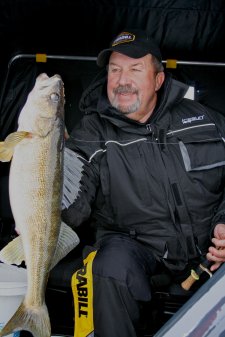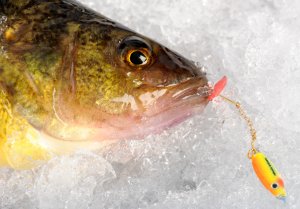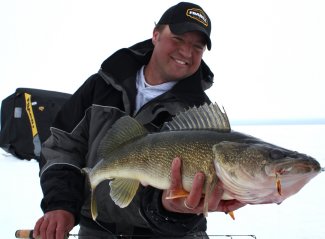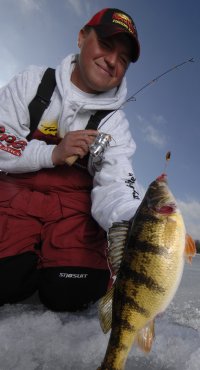Grave Diggin Walleyes…Bottom-Bound Tactics for Tough Times on Ice

“Working big walleyes on the bottom calls for maximum stealth.” (Photo courtesy of Frabill)
Sitting nice and snug inside the Frabill, it was hard to believe what had just happened. Jigging for walleyes at the end of a sweet little point, I’d watched on the camera screen as a good fish had swept in for a closer look at my spoon. Just as I began to anticipate a bite and hookset, a curious thing occurred. Instead of striking, the walleye just hovered there, inches from my lure, refusing to eat. I quivered the lure in place enticingly, even got the fish to chase up a few feet up before giving me another sound snubbing. Finally, amazingly, inexplicably, the minnow head dancing on the end of the treble hook shook itself free and fluttered down to rest on the bottom. Before I could even reel up and re-bait, the walleye dashed in, and with a violent flush of debris, vacuumed the minnow head right off the bottom. What the . . . ?
A short time later, Jon Marshall, MarCum Technologies Brand Manager, called to recount an interesting (and familiar) tale. Marshall and crew, it seemed, had just been out testing their new VS825SD color cameras on a lake near Minneapolis, when they made an amazing discovery. “We captured some really interesting video today,” Marshall recalled. “Found a pretty nice school of walleyes out there, but they absolutely would not bite. Until . . . he-heh-heh,” he cackled, anticipating my sudden curiosity.

“Bait-Chain Droppers add swing and flutter to a spoon, triggering walleyes as well as jumbo perch.” (Photo courtesy of Northland Fishing Tackle)
Apparently, just as Marshall and the boys were about to head home for the evening, one of the crew scooped a net full of dead minnows from the bucket and accidentally let them slide down the hole, whereupon they slowly descended toward the bottom. “Remember, we still had the camera down at this point,” Marshall continued, “when I noticed a single walleye sort of sitting there, nose down, looking at something on the bottom. Pop! The fish made a puff of silt and ate something, which I soon realized was one of our discarded minnow carcasses. Then, just as I told one of my buddies to check out what I’d seen, a second fish slid into view on the screen and ate another dead minnow. It was unbelievable. We’d have never believed it if we hadn’t seen it happen.”
But the story didn’t end there. Marshall and crew began that evening to experiment with different bottom-bound bait presentations, scratching out respectable catches of walleyes, all while the bite remained nearly nonexistent for other anglers hammering away with traditional baits and presentations.

“Even during the toughest bites of the winter, bottom-bound spoon and bait tactics ice big ‘eyes, like this one by ace guide Tony Roach.” (Photo courtesy of Frabill)
Meanwhile, famed Mille Lacs, Minnesota walleye guide Tony Roach has fished a similar pattern during post-coldfront outings for several years, putting fish on the ice for clients when the going gets super-tough. “After a front,” Roach says, “the fish aren’t moving much, so neither do we. I’ll pop up a big Frabill Headquarters shelter, turn on the heat and get my clients set up inside, ready to put in several hours of fishing on a prime piece of walleye real estate.”
Roach continues: “This is a great sight bite for using an underwater camera. In fact, it’s a necessary piece of gear here, because you need to keep your bait positioned perfectly, literally millimeters from the bottom. Our MarCum’s are also essential for showing you those ultra-subtle bites you can miss if you’re fishing by feeling alone.” The presentation, Roach reports, involves a 1/16-ounce Northland Forage Minnow Spoon or Live Forage Moxie Minnow fished stationary as a deadstick. He rigs each spoon with one of Northland’s new clip-on Bait-Chain Dropper Hooks, and tips it with a tiny lively shiner or fathead minnow.

“Dropper spoon tactics score monster perch that feed on bottom-dwelling invertebrates.” (Photo courtesy of Northland Fishing Tackle)
“It’s absolutely critical that you position the minnow so its tail just ever so slightly kicks up tiny puffs of bottom debris as it pulls against the spoon. The Bait-Chain features a gold-plated fine-link chain dropper that lets a lively minnow flutter and wavers freely near the bottom. You can either lip hook the minnow, or pierce the end of the tail, so the minnow looks like it’s feeding on the bottom, head-down. This move can really drive walleyes nuts, no matter how turned-off they are. And it’s deadly on big perch, too. Really saves my tail on those bitter, bluebird days after a cold front. Not to mention, my clients have a lot of fun watching walleyes and perch react to the presentation on screen.”
This brings us back to Marshall. After a little more investigative journalism on the part of yours truly, even MarCum’s Marshall, who’s usually super-secretive about hotspots and clandestine bites, finally spilled the beans on his secret bottom-bound bait method. “Take your favorite spoon,” he reluctantly offered. “I like a Kastmaster or Northland Buck-Shot. Then remove the treble and tie a super-long dropper line to the lower split ring.” Super long, in Marshall’s case, means a 6- to 10-inch length of 6-pound test monofilament tied to a #6 Eagle Claw 186 Baitholder hook. Thread on one to three fresh minnow heads or half a severed fathead or shiner minnow.
“Drop the spoon fast toward the bottom, and let it crash into the sediment. Pound it around down there just a bit. Helps attract fish into the area. Now just let the spoon sit motionless a few inches above the bottom, while the dropper follows slowly behind, bait fluttering gradually toward the bottom. You can keep doing short, occasional jigs with the spoon to attract fish, but when a walleye slides into view, keep things fairly still, the minnow head resting flat on the bottom. Fired-up fish might hit the spoon itself. But those really tough fish—especially the ones living in and around dense shantytowns, where they get used to eating the discarded minnows of anglers—might just surprise you with a nose-in-the-dirt bottom bite. You won’t believe it until you see it. And you know you want to believe, right?”

